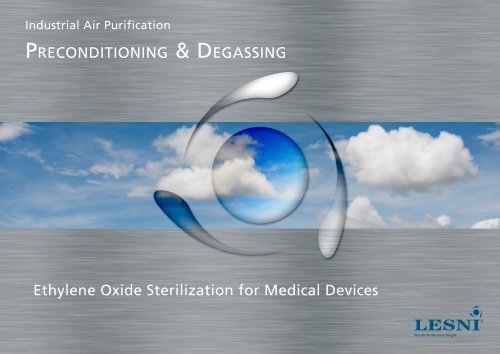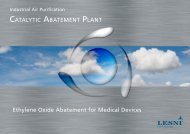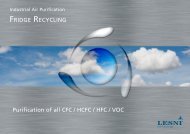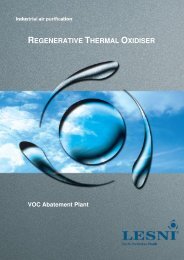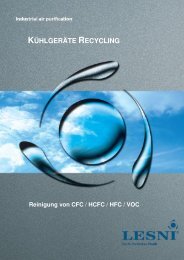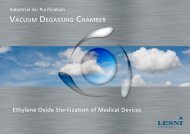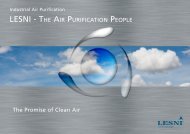Ethylenoxid Sterilisation - Vor- und Nachkonditionierungskammern
Create successful ePaper yourself
Turn your PDF publications into a flip-book with our unique Google optimized e-Paper software.
Industrial Air Purification<br />
Preconditioning & Degassing<br />
Ethylene Oxide Sterilization for Medical Devices
Ethylene Oxide (EtO) Sterilization<br />
Process<br />
1<br />
Preconditioning<br />
EtO gas infiltrates product as well as packages to kill microorganisms<br />
that are left during production or packaging processes.<br />
Consequently, safety of personnel and the environment is an<br />
important issue due to the harmful effect of EtO on humans, and<br />
measures to efficiently extract and purify all evacuated gas from<br />
the sterilizer as well as fugitive air from aeration after post sterilization.<br />
2<br />
3<br />
4<br />
Sterilization<br />
(Vacuum) Degassing - Aeration I<br />
Quarantine - Aeration II<br />
Processing occurs at temperatures aro<strong>und</strong> 45 – 55 °C, a lower temperature<br />
results in a less efficient process which leads to a longer<br />
exposure time. At least there are three stages in a typical EtO sterilization<br />
cycle, where cycle time is usually more than 14 hours, these<br />
are:<br />
• Preconditioning<br />
• Sterilization<br />
• Aeration (Degassing)<br />
5<br />
Air Purification<br />
When using this process, sufficient preconditioning, and multiple<br />
vacuum evacuation as well as degassing post sterilization is required;<br />
sometimes subsequent additional aeration of these medical<br />
devices are essential to reduce residual EtO levels to within acceptable<br />
limits complying with current European and international<br />
legislation. The design and operation of such degassing chamber<br />
should speed the rate of evaporation of the absorbed gas again<br />
from the sterilized items.
Sterilization Equipment<br />
The use of LESNI accelerated Degassing Cell and / or Vacuum Degassing<br />
Cell after sterilization can significantly reduce the post sterilization<br />
cycle time, and thus the need for large quarantine aeration<br />
rooms, while ensuring optimized treatment and purification of all<br />
fugitive emissions in the final Catalytic Abatement Plant.<br />
LESNI works to provide customers the opportunity to support the<br />
sterilization process and thus integrate where possible the installation<br />
of dedicated Preconditioning and Degassing Cells in a configuration<br />
that improves cycle time, reliability, and operation. The<br />
cells are designed and delivered to ensure high air circulation and<br />
exchange in a close environment where all relevant parameters and<br />
conditions are controlled in such a manner resulting in shorter process<br />
times.<br />
PRE-<br />
CONDITIONING<br />
AIR<br />
PURIFICATION<br />
STERILIZATION<br />
DEGASSING<br />
The Preconditioning and Degassing Cells are engineered to meet<br />
client’s cycle requirements ensuring maximized cell and utility usage<br />
performance. Our 2D and 3D conception and detail design facilities<br />
allow the client to visualize complete layout well before detail<br />
design and construction, to avoid delays.
Rev.date<br />
Replaces:<br />
Rev.sign.<br />
Rev.no. R<br />
Date<br />
23-05-20<br />
Tolerances after DS/ISO 2768C where n<br />
Weight<br />
Main dwg<br />
This drawing must not be shown or<br />
8<br />
7<br />
6<br />
5<br />
4<br />
3<br />
2<br />
F<br />
Preconditioning Cell<br />
E<br />
Preconditioning is a necessary step in the sterilization process,<br />
which prepares products / devices ahead of sterilization and save<br />
precious time inside the sterilizer, it enhances ethylene oxide<br />
penetration into the product and packaging.<br />
D<br />
In LESNI Preconditioning Cell the products are in a temperature and<br />
humidity controlled area.<br />
C<br />
A typical range for this preconditioning step is a temperature at 40<br />
– 60 °C and relative humidity of 50 – 65 %.<br />
B<br />
Product on pallets placed in closed, insulated chamber where air<br />
flow, temperature and relative humidity evenly distributed and<br />
maintained at pre-set values.<br />
A<br />
102652,43 kg<br />
8<br />
7<br />
6<br />
5<br />
4<br />
3<br />
2<br />
Preconditioning Sterilization Degassing Air Purification
Degassing Cell<br />
Degassing is the next step after sterilization to get residual ethylene<br />
oxide out of the packaging and products by aerating the cell<br />
with heated air.<br />
In LESNI Degassing Cell the products are in a temperature controlled<br />
environment, designed to ensure turbulent but accelerated air<br />
speed aro<strong>und</strong> the product to improve gas evaporation and reduce<br />
the degassing time.<br />
A typical operating range for this degassing step is a temperature<br />
at 40 –55 °C and several air changes.<br />
Aeration time may vary and is related to product type and different<br />
materials used, for this reason it is very important to have an efficient<br />
degassing and aeration stage to remove remaining EtO gas.<br />
Preconditioning Sterilization Degassing<br />
Air Purification
Saving Time and Space<br />
The use of LESNI accelerated Degassing Cell and Vacuum Degassing Cell<br />
after sterilization can significantly reduce the post sterilization cycle time,<br />
and thus the need for large quarantine aeration rooms, while ensuring<br />
optimized treatment and purification of all fugitive emissions in the final<br />
Catalytic Abatement Plant.
Reduction of Lead Time<br />
The benefit by using separate equipment for the sterilization process<br />
is a reduction of lead time during this process and is visualized in<br />
the following diagram, where parallel sterilization process of two<br />
different products / product mixes with variable preconditioning and<br />
degassing period, using two Preconditioning Cells, one sterilizer and<br />
two Degassing Cells, is compared with a sequential process operated<br />
by one sterilizer.
Vacuum Degassing<br />
Vacuum Degassing accelerate the evacuation of the residual ethylene oxide<br />
out of the packaging and products during aeration with heated air.<br />
The rapid degassing of EtO <strong>und</strong>er slight shallow vacuum expected to reduce<br />
time of degassing by 65 % or better depending on the vacuum break performed.<br />
When loaded with sterilized product the cell door will be closed and sealed,<br />
with turbulent air circulated evenly aro<strong>und</strong> the product to give a homogenous<br />
atmosphere mix. This circulated atmosphere will then be heated to the cycle<br />
selected temperature point and maintained.
Vacuum Degassing Cell Features<br />
Similar to standard Degassing Cell, a minimum air circulation rate will be targeted<br />
to achieve necessary turbulence throughout the cell. Also the air flow will<br />
be distributed and balanced along the full length of the cell to give an even<br />
distribution of cell temperature and air flow conditions throughout the load.<br />
The inlet and outlet ducting will be designed to give the best atmosphere flow<br />
across the surface of all the product within the cell.<br />
• Extraction of the internal cell atmosphere will be achieved by the<br />
vacuum pumping system and diverted to the final LESNI Catalytic<br />
Abatement Plant.<br />
• The Degassing Cell walls and door will be insulated all aro<strong>und</strong> to<br />
maintain a temperature variation across the free space of the cell.<br />
• A suitably sized vacuum pump will be fitted to extract Degassing Cell<br />
in a short time.<br />
• An air break from vacuum to atmospheric pressure will be installed to<br />
vent Degassing Cell in a similar period of time.<br />
• The Degassing Cell for this application will be constructed as a standalone<br />
cell / chamber to be placed on the floor adjacent to the sterilizer.
All aro<strong>und</strong> Sterilization<br />
The integration of the Preconditioning and Degassing Cells together with the<br />
well proven LESNI - EtO Catalytic Abatement System, ensures also complete<br />
EtO elimination and destruction from any environmental release to atmosphere.<br />
To meet continuous stringent requirements to reduce EtO residuals on the<br />
product, the LESNI Vacuum Pilot Degasser is available for testing and optimizing<br />
degassing cycle time. The unit is constructed to withstand shallow vacuum<br />
intervals of up to 700 mbar and is built for use with 3 EU pallets, with settings<br />
to control temperature, relative humidity and airflow circulation.<br />
This complement LESNI long history and contribution to the sterilization of<br />
medical devices industry, while help to achieve our goal and commitment to<br />
product excellence for this process.<br />
Preconditioning<br />
Sterilization<br />
1 2<br />
4 3<br />
Air Purification<br />
(Vacuum) Degassing
Design Parameters<br />
Following table and sketch will give you an idea about some possible parameters<br />
available to configure and design your cell to fit best to your existing<br />
sterilizer respectively sterilization process.
Air purification by physical and<br />
chemical scrubbers<br />
Activated carbon plants for VOC purification,<br />
odour removal and solvent recovery<br />
Air purification systems for removing mist, dust<br />
and particulate matter<br />
Safe and efficient catalytic and thermal oxidisers for VOC<br />
purification and solvent destruction<br />
LESNI has developed a variety of innovative solutions for specific<br />
pollutants and processes in operation worldwide<br />
LESNI A/S<br />
Kornmarken 7<br />
DK-7190 Bill<strong>und</strong><br />
Denmark<br />
Tel.: +45 7533 2500<br />
Fax: +45 7533 3006<br />
info@lesni.com<br />
www.lesni.com<br />
Sales Office<br />
Tel.: +44 121 439 3278<br />
sales@lesni.com


